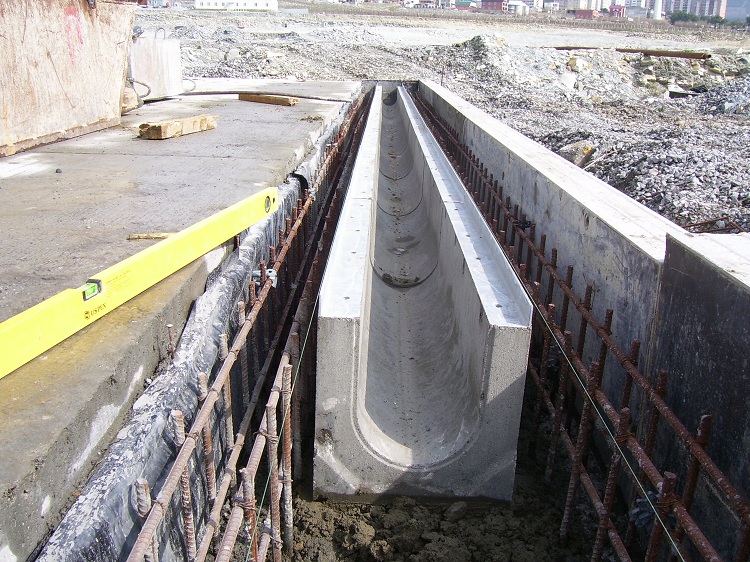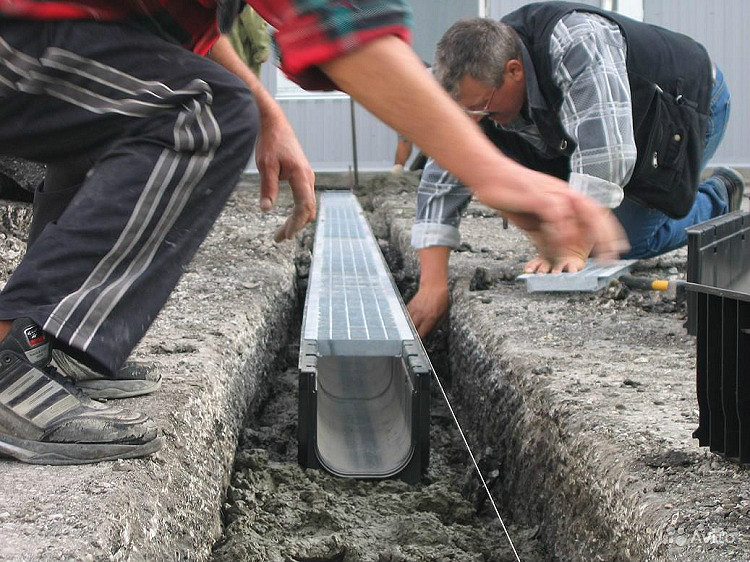The design of all surface drainage systems without fail includes a drainage tray. It can be cast iron, reinforced concrete, plastic, composite. The product is designed to remove excess moisture arising after rains or during the melting of snow. Mount the drainage drainage tray near the road curbs, under the drainpipes and near the end of the annular blind area. And their gratings play the role of a primary filter.
Content [Hide]
Design features
A typical tray is a U-shaped channel, covered from the open side by the aforementioned cast-iron grate. European standard EN 1433 regulates the production of 4 types of such products.
The tray is waste. It looks like a straight groove and is designed to receive fluid along its entire length. Available in the spirit of options:
- execution of "I". Provides for installation without foundation and lining;
- execution of "M". Equipped with its own foundation.
Box tray. It has the shape of a U-shaped trough, the top cover of which is removed. It prevents large items from being washed away by wastewater into the feed channel of the tray.
The slotted tray. It is a square beam, along the central axis of which there is a round through hole. Access to the drain is provided through a slot located in its upper part. It is longitudinal continuous or intermittent. Such a product is an excellent replacement for the box tray with a grate.
The tray is curb. This is nothing more than a G-shaped slotted groove with a protrusion of the upper part, which covers the gap present in its body.
All described drainage trays are also mounted close to the curbs along the paths being arranged in the garden, and not just directly under the gutters. The most durable products are used at airports, in heavy vehicle parking lots, as well as on highways.
What materials are the trays made of?
Currently, production of similar products of the following types has been established.
1. Tray drainage polymer. It is made from polypropylene, in which mineral filler is added. This material has a high strength indicator (can withstand a load of up to 60 tons per square meter) and significant resistance (almost no scratches are applied and, in addition, it is inert to most chemicals). The working temperature of such raw materials ranges from -50≤T≤ + 120ºC. Therefore, a plastic drainage tray is laid both near the building and near the railway track.
Good to know! The weight of one module reaches 14 kilograms.
This product has the following standard sizes:
- the value of the conditional diameter is from 10;
- height 6≤H≤79 cm;
- width 14≤W≤59 cm;
- length 100 cm.
If we talk about the price of a plastic drainage tray, then it is quite affordable to the budget of the owner of the most ordinary house or summer house.
2. Reinforced concrete tray. Manufacturing technology - vibrocompression of a parabolic or rectangular shape. This production method has been mastered by most domestic concrete products factories.
This product is divided into the following types:
- trapezoidal trays. The most widely used in the construction of bridges and roads for the arrangement of storm sewers and drainage. Due to the installation features, the trapezoidal trays are called “telescopic”. A single channel is formed from the upper to the lower point (down the slope) due to the fact that these products are inserted into the grooves present in the design of each of them. Open areas are covered with bars;
- parabolic or round trays. Due to the more aesthetic appearance, a drainage reinforced concrete tray of this type can often be seen in park areas and in adjoining territories. The created system is also closed by a grid. In addition to coarse filtering of large garbage, it gives the design a more aesthetic appearance.
The generally accepted dimensions of the reinforced concrete drainage tray are:
- length - 1 meter;
- height 90≤H≤760 mm;
- width 100≤W≤500 mm;
- the height of the channel can be fixed or with a five percent slope.
In addition, there are trays of rectangular or square cross section. But they are not used for the purpose of drainage, but for laying in the ground pipelines for various purposes - water pipes, heating mains, communication and electric cables. Such trays protect engineering communications from the effects of negative environmental factors.
3. Polymer concrete tray. This product is made from a mixture of quartz sand, basalt and granite chips and special polyester and epoxy resins. Due to the partial replacement of cement with a polymer substance, the drainage drainage polymer concrete tray perfectly resists the effects of chemically active substances. And the addition of plastic components to the mixture reduces the weight of the final product compared to the reinforced concrete analogue by half. The presence of polymer components gives the drainage surface increased smoothness, as a result of which sand, leaves and other debris do not linger inside the structure. In addition, the level of water resistance of such products is much higher than that of trays made from other materials.
Of their advantages, it is worth highlighting:
- install polymer concrete tray in the ground or a special channel is not difficult;
- wide range of use;
- combining the advantages of concrete and plastic structures, this material significantly exceeds them in terms of performance and physico-chemical properties.
Important! The drainage polymer concrete tray successfully performs the function of protecting groundwater from drains containing large quantities of chemicals that are emitted by some enterprises. The material withstands the effects of road reagents and fuel and lubricants.
The technical specifications of this product are as follows:
- the internal cross section varies between 100≤S≤300 millimeters;
- the throughput of a single section varies in the range of 1.8≤Tc≤34.9 l / s;
- the weight of one element may be: 1≤P≤6.85 kilograms.
How to choose a product
When choosing such products, two main characteristics must be taken into account: throughput and maximum allowable load.
According to the last criterion, drainage trays form the groups presented in the table below.
Table 1
| Group id | Load no more, tons | Where are installed |
| F900 | 90 | At military bases and airfields |
| E600 | 60 | Near warehouses, logistics centers, industrial enterprises. |
| D400 | 40 | On roads, on which all types of transport are allowed, on automobile enterprises, in industrial zones. |
| S250 | 25 | In car services, in car washes, gas stations. |
| B125 | 12,5 | In urban garage cooperatives, and in front of suburban garages, in parking lots, under the roads for cars |
| A15 | 1,5 | Under the garden paths in the countryside, park and bike paths, urban pedestrian areas, sports fields. |
As for the throughput, it is calculated taking into account the requirements for storm sewers. The critical parameters are the height and width of the product. Installation of A15 elements is allowed near the country house, while at the entrance to the courtyard - D400. This will ensure safe check-in of the dump truck and even the tractor (if necessary).
Calculation of the cross section of the drain pan
In order to correctly select the cross section of the elements of the surface drainage system, it is necessary to carry out at least a minimum hydraulic calculation. In this case, the following factors must be taken into account: estimated runoff area, indicator (characteristic) of the surface of the runoff basin, and precipitation intensity in a particular area. These parameters serve as input to the calculation of water flow. The unit is (liter / second) / ha. Select a drainage drainage tray based on the results of calculating its throughput. The value of this indicator depends on the number of exits into the stormwater drain (so the builders call the storm sewer) and the angle of the drainage line.
The amount of precipitation on the working area is calculated by the following formula:
KO = K * IO * PS,
where: KO - amount of precipitation; K is the coefficient characterizing the features of the surface of the drainage basin; ИО - precipitation intensity; PS - estimated flow area.
The runoff surface coefficient is presented in the table below.
table 2
| Coefficient | Surface type |
| 0,05-0,36 | Grassy area. The value of the coefficient depends on the soil |
| 0,15-0,3 | Gravel |
| 0,25- 0,6 | Macadam |
| 0,45 | Coating blocks connected without insulation |
| 0,6 | Paving stones connected without insulation |
| 0,8 | Pavers connected by cement |
| 0,9 | Concrete or asphalt |
For a complete understanding of the calculation issue, see the following example:
drain area - PS = 600 m²;
the coating is asphalt, that is, K = 0.9;
in the metropolitan region, the intensity of precipitation is: ИО = 80,
After substituting these data into the formula, the following result will be obtained:
KO = 0.9 × (80 l / s × 600) / 10000 = 4.32.
To determine the appropriate tray, we compare this result with the data from the table below (the table displays information on plastic trays).
Table 3
| Name | Slope | ||||||
| 0,1 | 0,05 | 0,03 | 0,02 | 0,015 | 0,01 | 0,005 | |
| Drainage tray LV type -20.260.20 | 93,83 | 66,35 | 51,40 | 41,96 | 36,34 | 29,67 | 20,98 |
| LV-10.160.15,5 | 24,12 | 17,10 | 13,20 | 10,79 | 9,35 | 7,63 | 5,39 |
| LV -10.14.50.12 | 6,51 | 4,60 | 3,56 | 2,90 | 2,48 | 2,05 | 1,45 |
| LV-10.14.50.06 | 13,54 | 9,57 | 7,42 | 6,0 | 5,24 | 4,28 | 1,35 |
Good to know! For such products made of other materials, there are tables.
As a result of the comparison, we will find that the LV-10.14.50.12 model installed at an angle of 0.05 m / linear meter will be the best drainage option for the capital region. meter.
Installation of polymer concrete trays
To equip the drainage system using a drainage tray of this type, the contractor will have to perform the following sequence of actions:
- mark the territory according to the developed project;
- Dig trenches in designated places. The depth of each of them is determined by the height of the used tray. Install this element so that the edges are 5 cm below the ground. In addition, it is necessary to ensure a reserve of depth for the installation of a concrete or sand base;
- to ensure the efficiency of the drainage system, the channels are laid with a slope of 1 cm / 1 linear. meter;
- tamp the bottom of the prepared trenches with a manual tamper. To fill up a layer of sand. Its thickness should be 5 cm. If the soil is weak in the area, the arrangement of a concrete base should be provided. Full concreting of trenches, in other words, coating with concrete mortar, both the bottom and the walls, increases the service life of the drainage tray;
- install elements of the drainage system with simultaneous control of the value of the angle of inclination;
- dock them with each other. This is done using special latches;
- to give the system greater reliability, the joints are treated with a special adhesive sealant. When choosing this tool, preference should be given to one that is characterized by resistance to low temperatures and high humidity;
- install on top of each element of the created grid drainage system.
The created system is connected to the sewer network through a sand trap. The filter of this device, as well as the drainage tray itself, must be regularly cleaned from accumulated debris. Otherwise, the throughput of the entire structure will decrease.












